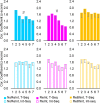Susceptibility of consolidated procedural memory to interference is independent of its active task-based retrieval
- PMID: 30653576
- PMCID: PMC6336251
- DOI: 10.1371/journal.pone.0210876
Susceptibility of consolidated procedural memory to interference is independent of its active task-based retrieval
Abstract
Reconsolidation theory posits that upon retrieval, consolidated memories are destabilized and need to be restabilized in order to persist. It has been suggested that experience with a competitive task immediately after memory retrieval may interrupt these restabilization processes leading to memory loss. Indeed, using a motor sequence learning paradigm, we have recently shown that, in humans, interference training immediately after active task-based retrieval of the consolidated motor sequence knowledge may negatively affect its performance levels. Assessing changes in tapping pattern before and after interference training, we also demonstrated that this performance deficit more likely indicates a genuine memory loss rather than an initial failure of memory retrieval. Here, applying a similar approach, we tested the necessity of the hypothetical retrieval-induced destabilization of motor memory to allow its impairment. The impact of memory retrieval on performance of a new motor sequence knowledge acquired during the interference training was also evaluated. Similar to the immediate post-retrieval interference, interference training alone without the preceding active task-based memory retrieval was also associated with impairment of the pre-established motor sequence memory. Performance levels of the sequence trained during the interference training, on the other hand, were impaired only if this training was given immediately after memory retrieval. Noteworthy, an 8-hour interval between memory retrieval and interference allowed to express intact performance levels for both sequences. The current results suggest that susceptibility of the consolidated motor memory to behavioral interference is independent of its active task-based retrieval. Differential effects of memory retrieval on performance levels of the new motor sequence encoded during the interference training further suggests that memory retrieval may influence the way new information is stored by facilitating its integration within the retrieved memory trace. Thus, impairment of the pre-established motor memory may reflect interference from a competing memory trace rather than involve interruption of reconsolidation.
Conflict of interest statement
The authors have declared that no competing interests exist.
Figures





Similar articles
-
Re-stepping into the same river: competition problem rather than a reconsolidation failure in an established motor skill.Sci Rep. 2017 Aug 24;7(1):9406. doi: 10.1038/s41598-017-09677-1. Sci Rep. 2017. PMID: 28839217 Free PMC article.
-
Motor memory consolidation processes in young female adults with ADHD may be less susceptible to interference.Neurosci Lett. 2017 Jan 10;637:91-95. doi: 10.1016/j.neulet.2016.11.044. Epub 2016 Nov 22. Neurosci Lett. 2017. PMID: 27888044
-
Sleep and memory consolidation: motor performance and proactive interference effects in sequence learning.Brain Cogn. 2015 Apr;95:54-61. doi: 10.1016/j.bandc.2015.01.011. Epub 2015 Feb 14. Brain Cogn. 2015. PMID: 25682352
-
Determinants to trigger memory reconsolidation: The role of retrieval and updating information.Neurobiol Learn Mem. 2017 Jul;142(Pt A):4-12. doi: 10.1016/j.nlm.2016.12.005. Epub 2016 Dec 21. Neurobiol Learn Mem. 2017. PMID: 28011191 Review.
-
Reconsolidation of human motor memory: From boundary conditions to behavioral interventions-How far are we from clinical applications?Behav Brain Res. 2018 Nov 1;353:83-90. doi: 10.1016/j.bbr.2018.07.003. Epub 2018 Jul 3. Behav Brain Res. 2018. PMID: 29983391 Review.
Cited by
-
Initial motor skill performance predicts future performance, but not learning.Sci Rep. 2023 Jul 13;13(1):11359. doi: 10.1038/s41598-023-38231-5. Sci Rep. 2023. PMID: 37443195 Free PMC article.
-
Better later: evening practice is advantageous for motor skill consolidation in the elderly.Learn Mem. 2021 Feb 16;28(3):72-75. doi: 10.1101/lm.052522.120. Print 2021 Mar. Learn Mem. 2021. PMID: 33593924 Free PMC article.
-
Does Motor Memory Reactivation through Practice and Post-Learning Sleep Modulate Consolidation?Clocks Sleep. 2023 Feb 17;5(1):72-84. doi: 10.3390/clockssleep5010008. Clocks Sleep. 2023. PMID: 36810845 Free PMC article.
-
Reactivation-induced memory integration prevents proactive interference in perceptual learning.J Vis. 2023 May 2;23(5):1. doi: 10.1167/jov.23.5.1. J Vis. 2023. PMID: 37129883 Free PMC article.
-
Experience-driven competition in neural reorganization after stroke.J Physiol. 2025 Feb;603(3):737-757. doi: 10.1113/JP285565. Epub 2024 Oct 30. J Physiol. 2025. PMID: 39476290 Review.
References
-
- McGaugh JL. Memory—a century of consolidation. Science. 2000;287: 248–251. - PubMed
Publication types
MeSH terms
Grants and funding
LinkOut - more resources
Full Text Sources

